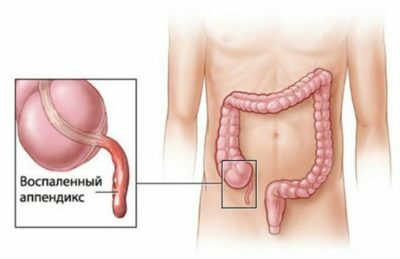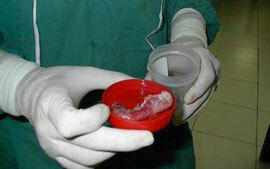1 Types and causes of
There are following forms of infiltration:
- Inflammatory - occurs most often, can be purulent, consisting of leukocytes, hemorrhagic( erythrocytes), lymphoid and histiocytic-plasma cell. The causes of the accumulation of biological fluids and, as a consequence, the inflammatory process are the causative agents of infectious diseases( streptococci, staphylococcus, E. coli), trauma, surgical operations on the abdominal cavity organs( postoperative infiltrate), acute destructive appendicitis, which provokes the appearance of an appendicular infiltrate, acute destructive cholecystitisand pancreatitis.
- Tumor is manifested by changes in color, volume and density of tissues and consists of tumor cells( myoma, sarcoma).Weakened immunity, allergic and chronic diseases contribute to the development of this pathology in different ways.
- Postoperative - may occur due to: improper drainage, poor hemostasis, insufficient sanitation or soaking of tissues with alcohol, iodine or anesthetic solution, mechanical damage to organs tissues or the abandonment of foreign bodies during the operation. Low-quality surgical threads provoke the emergence of a suture( ligature) infiltrate, which can appear in a couple of months, a year or even several years.
- Appendicular - occurs due to the reaction of the peritoneum to an acute inflammatory process and manifests itself in the limitation of the latter( delimited peritonitis).Infiltrate develops within 3 days after the onset of acute appendicitis and includes appendix, dome of the cecum, intestinal loops and peritoneum.
Do you have gastritis?
GALINA SAVINA: "How easy is it to cure gastritis at home for 1 month. A proven method - write down a recipe. ..!"Read more & gt; & gt;

Recommended to consult
- Symptoms of inflammation of the abdominal cavity
- Signs and treatment of amebiasis
- Duration of admission after removal of appendicitis
- Effective agent for gastritis and gastric ulcer
2 Clinical picture and diagnosis
The abdominal infiltrate is characterized by aching pain in the affected area, redness and swelling of the area of the skin,temperature increase to subfebrile, disruption of intestinal function( constipation, diarrhea, difficulty with the escape of gases).Intoxication weakly expressed. At a palpation the density is felt, the pain amplifies and the dent which does not disappear at once is formed. Careful collection of anamnesis is important for differential diagnosis and diagnosis.

If the infiltrate is located behind a muscle group, the diagnosis becomes more difficult. In this case, it is necessary to perform echographic examination and computed tomography to determine the structure and its exact location, as well as the presence of an abscess. Biopsy is conducted in doubtful cases to determine the nature of the cells that are inside the infiltrate.
-
 IMPORTANT TO KNOW! Gastritis? Ulcer? To have a stomach ulcer not turned into cancer, drink a glass. ..Read the article & gt; & gt;
IMPORTANT TO KNOW! Gastritis? Ulcer? To have a stomach ulcer not turned into cancer, drink a glass. ..Read the article & gt; & gt;
3 Principles of treatment of
In the early detection of pathology, the inflammatory process without purulent formations is eliminated by conservative therapy, which includes: antibacterial( including lymphotropic) or anti-inflammatory drugs, local hypothermia( cold on the peritoneum), physiotherapy( electrophoresis, ultraviolet and electromagneticirradiation), restorative procedures and a sparing regimen.
Treatment of suture infiltrate also includes antibiotics and physiotherapy. In the absence of resorption of education, opening and cleaning of the joints is carried out.
Treatment of appendicit infiltrate depends on the stage of the disease. In the initial stage, possible drug treatment with the subsequent removal of the appendix( a few months).Abscessing of the appendicular infiltrate is characterized by a sharp deterioration in the state( chills, fever, acute soreness in the right side of the abdomen) and requires surgical intervention, in which the abscess is opened, and the appendix remains until the inflammation ceases. The vermiform appendix is removed within 5-6 months.
-
 Gastroenterologist VAZHENOV: "I beg you, if you started to worry about abdominal pain, heartburn, nausea, do not do gas in any way. .."Read more & gt; & gt;
Gastroenterologist VAZHENOV: "I beg you, if you started to worry about abdominal pain, heartburn, nausea, do not do gas in any way. .."Read more & gt; & gt;
In the formation of an abscess, peritonitis or the presence of tumor cells, a surgical operation is performed. Depending on the degree of abscess, a minimally invasive procedure is performed with drainage of the purulent focus. In severe cases, laparoscopy or laparotomy is performed. With peritonitis, a large cavity operation is performed. Correctly performed sanation and drainage of the abdominal cavity play an important role in preventing the development of postoperative complications.
- 1 Species and causes of
- 2 Clinical picture and diagnosis
- 3 Principles of treatment
An abdominal infiltrate is a compaction that occurs in the tissues of the abdominal organs due to a pathological accumulation of cellular elements along with blood and lymphoma without signs of infection. Timely elimination of infiltration is necessary to prevent an abscess - severe purulent inflammation.



